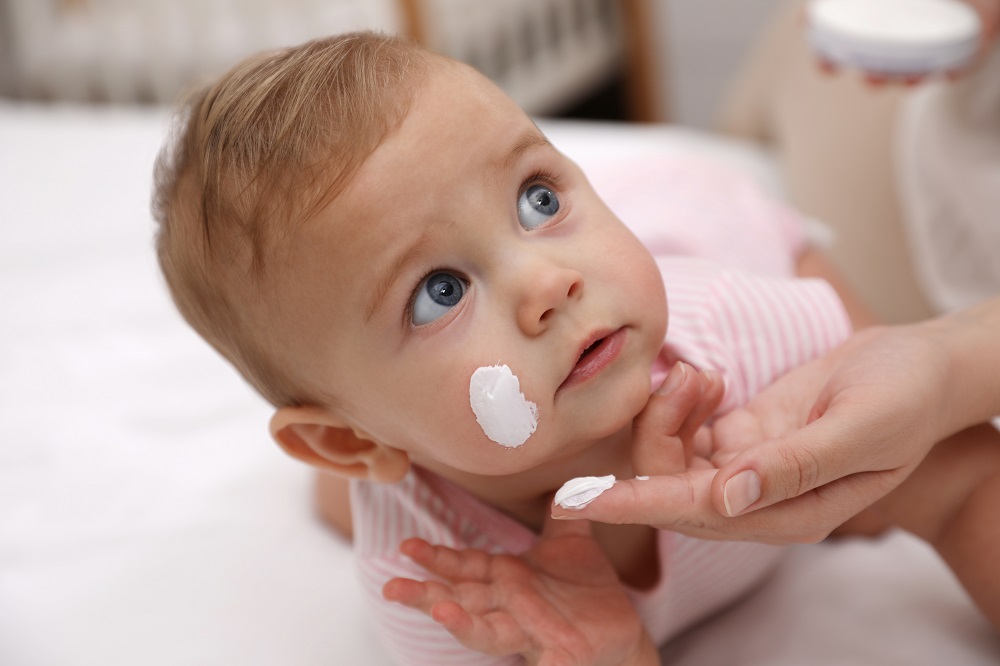Each season brings unique challenges for baby skincare. While spring and summer bring a higher risk of diaper rash and heat rash, fall and winter increase the risk of dry skin problems. The cold air outside and indoor heating during winter and fall can leave your little one’s skin dry, leading to issues like chapped lips or baby eczema flare-ups. This is why changing your baby’s skincare routine depending on the season is important.
Ways to Protect Your Baby’s Skin in Fall and Winter
1. Apply Baby Sunscreen when going Outdoors
Most of us only focus on sunscreen during summer, but the sun’s UV rays can damage our skin even during the colder months. There are two main types of sunscreens – barrier sunscreens and chemical sunscreens. As the name suggests, barrier sunscreens contain minerals that remain on the skin’s surface and act as a shield against UV rays but chemical sunscreens are absorbed by the skin and enter the bloodstream. Some of the chemicals in chemical sunscreens, such as oxybenzone and octinoxate, are known as endocrine-disrupting chemicals (EDCs), which could have a negative impact on your baby’s development. Furthermore, some of the chemicals in these sunscreens are harsh and can irritate a baby’s delicate skin. If your little one is six months or older, you should always apply a barrier-type sunscreen that is meant specifically for babies before leaving home. Not all baby sunscreens are equally good, so compare the top baby sunscreens that have been vetted by independent experts to choose the one that suits your baby.
2. Switch to a Heavier Moisturizer
During the summer, babies sweat more, so they need a lightweight moisturizer to keep their skin hydrated without clogging their pores. However, in winter and fall, the air outside is cold and dry, so they need a heavier moisturizer. Thicker moisturizers are better at trapping skin moisture and preventing drying. Even if you are not taking your little one outdoors, you should still apply their moisturizer daily as the warm dry air in your home increases the risk of dry skin.
3. Reduce Bathing
Your little one may need daily baths during summer, but this is not the case during winter and fall. According to recommendations from the AAD (the American Academy of Dermatology Association), you can bathe your baby between one to three times a week. If you’ve come in from the cold, you might want to give your baby a warm or hot bath to help them get warm, but this is a bad idea because hot water will strip your baby’s skin of natural oils and increase the risk of dry skin problems. Always use lukewarm water for your baby’s baths and apply moisturizer immediately to lock in moisture.
4. Invest in a Humidifier
The air in winter and fall already has a lower moisture content, and indoor heating reduces these levels even further. Using a humidifier in your baby’s room will increase the amount of moisture in the air, preventing their skin from becoming dry. This is particularly useful if your baby already has chapped lips, eczema, or dry skin, as the humid air will support faster skin recovery. In addition to protecting your baby’s skin, the moist air will soothe their nasal passages and reduce the risk of coughing caused by dry indoor air.
5. Choose the Right Winterwear
Parents often worry about their babies feeling cold when going out in winter and fall, so they dress them in several layers of thick clothing. This is a mistake because too many thick layers can result in overheating, which will make your little one uncomfortable and sweaty, and it can even cause a skin rash. Dress your baby in layers of soft and breathable fabrics like cotton, and avoid synthetic materials and wool, as these can cause itching and rashes. You will need two or three layers of clothing depending on how cold it is where you live. Check your child’s stomach occasionally – your baby’s skin should feel warm but not sweaty. If your baby’s skin is clammy, remove a layer of clothing.

